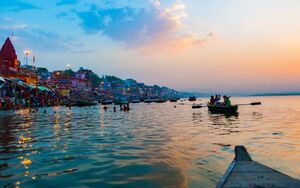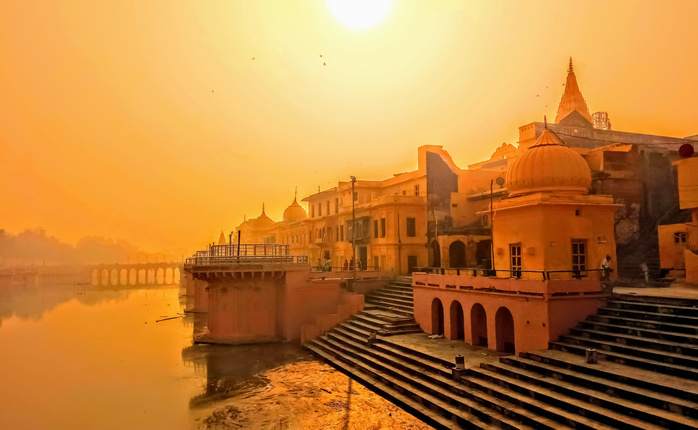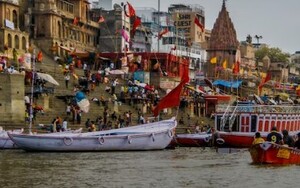Best Time to Visit Ayodhya
Ayodhya, with its rich historical and cultural significance, is a captivating destination that beckons visitors throughout the year. However, the best time to visit Ayodhya is during the months of October to March, when the weather is pleasantly cool, making exploration of the city's landmarks and religious sites enjoyable. During this period, individuals experience a moderate temperature Ayodhya, ranging from 10 to 25 degrees Celsius, providing a comfortable atmosphere for tourists.
The winter months, particularly December and January, showcase Ayodhya at its best, with clear skies and a pleasant breeze. This time of the year allows travellers to delve into the city's vibrant history, visit revered temples, and experience the cultural charm without being hindered by the extreme temperature Ayodhya.
Most Popular Ayodhya Tour Packages
Conversely, the summer months, from April to June, witness higher temperature Ayodhya, often exceeding 40 degrees Celsius. The scorching heat may make outdoor excursions less appealing, but those seeking a quieter atmosphere can explore the city's serenity during this period. It's advisable to carry light clothing and stay hydrated if planning a trip during the summer.
Monsoon arrives in Ayodhya between July and September, bringing relief from the heat but also occasional heavy rainfall. While the lush green surroundings enhance the city's beauty, travellers should be prepared for wet conditions. Ayodhya tour packages during this season often include visits to historical sites along with opportunities to witness the city's transformation amid the rain.
The Ayodhya best time to visit is from October to March when the weather Ayodhya is pleasant, allowing visitors to fully appreciate the city's cultural and historical offerings. Travellers can choose from various Ayodhya holiday packages tailored to their preferences, ensuring a memorable exploration of this ancient city.
Season Calendar Monthwise
|
Month
|
Weather
|
Temperatures
|
Precipitation
|
|
January
|
Cool and Pleasant
|
7°C to 22°C
|
Minimal
|
|
February
|
Mild Winter
|
10°C to 25°C
|
Negligible
|
|
March
|
Transition to Summer
|
15°C to 30°C
|
Minimal
|
|
April
|
Early Summer
|
20°C to 35°C
|
Low
|
|
May
|
Warm and Hot
|
25°C to 40°C
|
Moderate
|
|
June
|
Peak Summer
|
30°C to 42°C
|
Moderate
|
|
July
|
Monsoon Begins
|
25°C to 35°C
|
High
|
|
August
|
Rainy Season Peaks
|
25°C to 35°C
|
High
|
|
September
|
Lingering Monsoon
|
25°C to 35°C
|
Moderate
|
|
October
|
Refreshing Autumn
|
15°C to 30°C
|
Low
|
|
November
|
Pleasant Pre-Winter
|
10°C to 25°C
|
Minimal
|
|
December
|
Winter Sets In
|
7°C to 22°C
|
Negligible
|
Summer In Ayodhya
As the mercury rises in Ayodhya during the summer months (April to June), the city transforms into a vibrant tapestry of cultural and festive celebrations. Despite the soaring Ayodhya temperature, this period has its own allure, offering a unique experience for visitors.
Ayodhya, known for its rich religious heritage, hosts festivals like Ram Navami with grandeur during this season. Pilgrims from across the country converge to partake in the festivities, creating a lively atmosphere. The temperature Ayodhya during summer can reach up to 40 degrees Celsius, making it essential to plan activities wisely.
While outdoor explorations might be challenging in the heat, the evenings provide a more comfortable setting for visiting places like Ram Janmabhoomi and Kanak Bhavan. The local cuisine also adds flavour to the experience, with refreshing drinks like thandai and delectable sweets such as malpua and jalebi.
Considering the weather Ayodhya, it's advisable to schedule indoor activities or take part in cultural events and religious ceremonies during the summer. Ayodhya trip packages designed for this season often include curated experiences that ensure a memorable visit, making it a distinct and culturally rich chapter in the city's best time to visit Ayodhya.
Monsoon In Ayodhya
Ayodhya dons a lush and vibrant avatar during the monsoon season (July to September), turning the city into a captivating haven for enthusiasts seeking a unique experience. While the rain in Ayodhya enhances the scenic beauty, it also brings forth distinctive festivities and activities.
One of the notable festivals during this period was Guru Purnima, celebrated with fervour. Pilgrims often visit Ayodhya to participate in rituals and seek blessings. The temperature Ayodhya during monsoon hovers around 25 to 35 degrees Celsius, creating a pleasant ambience for exploration.
Exploring Ayodhya's historical sites like Hanuman Garhi and Treta Ke Thakur becomes enchanting with the gentle rain in Ayodhya. The weather Ayodhya allows for outdoor activities, and the city's parks and gardens are rejuvenated, making it an ideal time for nature enthusiasts. Ayodhya tour packages tailored for this season often incorporate visits to these revitalised green spaces.
Indulging in local delicacies like pakoras and chai during the monsoon is a delightful experience. Ayodhya holiday packages designed for this time frame often include culinary escapades, allowing visitors to savour the city's flavours. Embracing the monsoon spirit, Ayodhya becomes a captivating destination, offering a distinct charm within its overall best time to visit Ayodhya.
Winter In Ayodhya
Ayodhya's winter charm (October to March) envelops the city in a serene and pleasant ambience, making it the best time to visit Ayodhya. The temperature Ayodhya during winter ranges from a cool 10 to 27 degrees Celsius, offering an ideal climate for exploration.
The winter season in Ayodhya witnesses the celebration of Diwali, a festival of lights, magnifying the city's spiritual aura. Pilgrims and tourists flock to experience the grandeur of Ram Ki Paidi illuminated with earthen lamps. The crisp weather Ayodhya enhances the festive atmosphere, making it a mesmerising spectacle.
Activities abound during this season, with tourists enjoying leisurely strolls along the Sarayu River and exploring architectural marvels like Nageshwarnath Temple. Ayodhya tour packages designed for winter often include guided tours to historical sites, allowing visitors to soak in the city's rich heritage comfortably.
Indulging in Ayodhya's winter delicacies, such as piping hot jalebis and chaat, becomes a culinary delight. The weather Ayodhya permits unhurried exploration of local markets like Chowk, offering traditional handicrafts and souvenirs. Embracing the winter spirit, Ayodhya provides a tranquil and culturally rich experience within its overall best time to visit Ayodhya.
People also ask about Best Time to Visit Ayodhya
What is the best time to visit Ayodhya?
The Ayodhya best time to visit is during the winter months, from October to March. The weather during this period is pleasantly cool, ranging from 10 to 27 degrees Celsius, providing an ideal climate for a comprehensive exploration of the city's cultural and historical landmarks.
How is the Ayodhya temperature during other seasons?
Ayodhya temperature experiences distinct seasons. Summer, from April to June, witnesses soaring Ayodhya temperature up to 40 degrees Celsius, making outdoor activities challenging. Monsoon, from July to September, brings relief but also considerable rainfall, impacting travel plans.
Why is winter considered the best time to visit Ayodhya?
Winter in Ayodhya offers a comfortable Ayodhya temperature, making outdoor activities and sightseeing more enjoyable and the Ayodhya best time to visit. The festive season, including Diwali celebrations, adds a cultural vibrancy to the city, enhancing the overall travel experience.
Are there activities planned for visitors during the best time to visit Ayodhya?
Ayodhya tour packages tailored for the winter season often include guided tours to historical sites like Ram Janmabhoomi and Hanuman Garhi making it the Ayodhya best time to visit. The weather allows for leisurely strolls along the Sarayu River and exploration of local markets.
Are there specific festivals during the best time to visit Ayodhya?
Yes, winter hosts festivals like Diwali, enhancing Ayodhya's spiritual and cultural charm. Pilgrims and tourists often visit during this season to witness the grandeur of illuminated ghats and participate in celebrations.
Is Ayodhya suitable for visits during the summer season?
While Ayodhya experiences high Ayodhya temperature during summer (April to June), it can be challenging for outdoor activities. The scorching heat makes it less favourable for comprehensive exploration, but indoor and evening activities can still be enjoyable.
How does Ayodhya transform during the monsoon season?
Ayodhya during monsoon (July to September) becomes lush and green, offering a unique charm. Festivals like Guru Purnima are celebrated during this time, and the gentle rain enhances the overall beauty of the city.










